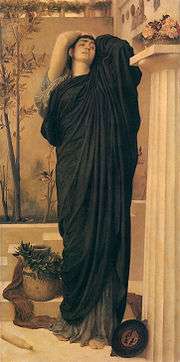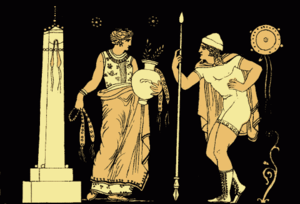Electra complex

In Neo-Freudian psychology, the Electra complex, as proposed by Carl Gustav Jung, is a girl's psychosexual competition with her mother for possession of her father. In the course of her psychosexual development, the complex is the girl's phallic stage; formation of a discrete sexual identity, a boy's analogous experience is the Oedipus complex. The Electra complex occurs in the third—phallic stage (ages 3–6)—of five psychosexual development stages: (i) the Oral, (ii) the Anal, (iii) the Phallic, (iv) the Latent, and (v) the Genital—in which the source libido pleasure is in a different erogenous zone of the infant’s body.
In classical psychoanalytic theory, the child's identification with the same-sex parent is the successful resolution of the Electra complex and of the Oedipus complex; his and her key psychological experience to developing a mature sexual role and identity. Sigmund Freud instead proposed that girls and boys resolved their complexes differently—she via penis envy, he via castration anxiety; and that unsuccessful resolutions might lead to neurosis and homosexuality. Hence, women and men who are fixated in the Electra and Oedipal stages of their psychosexual development might be considered "father-fixated" and "mother-fixated" as revealed when the mate (sexual partner) resembles the father or the mother.
Background

As a psychoanalytic term for daughter–mother psychosexual conflict, the Electra complex derives from the 5th-century BC Greek mythologic character Electra, who plotted matricidal revenge with Orestes, her brother, against Clytemnestra, their mother, and Aegisthus, their stepfather, for their murder of Agamemnon, their father (cf. Electra, by Sophocles).[1][2][3] Sigmund Freud developed the female aspects of the sexual development theory—describing the psychodynamics of a girl’s sexual competition with mother for sexual possession of father—as the feminine Oedipus attitude and the negative Oedipus complex;[4] yet it was his collaborator Carl Jung who coined the term Electra complex in 1913.[5][6][7] Freud rejected Jung's term as psychoanalytically inaccurate: "that what we have said about the Oedipus complex applies with complete strictness to the male child only, and that we are right in rejecting the term 'Electra complex', which seeks to emphasize the analogy between the attitude of the two sexes".[8]
In forming a discrete sexual identity (ego) a girl's decisive psychosexual experience is the Electra complex—daughter–mother competition for possession of father.[9] It is in the phallic stage (ages 3–6), when children become aware of their bodies, the bodies of other children, and the bodies of their parents that they gratify physical curiosity by undressing and exploring each other and their genitals—the erogenous center—of the phallic stage; thereby learning the physical differences between "male" and "female" and the gender differences between "boy" and "girl". When a girl's initial sexual attachment to mother ends upon discovering that she has no penis, she then transfers her libidinal desire (sexual attachment) to father and increases sexual competition with her mother.
Characteristics
The psychodynamic nature of the daughter–mother relationship in the Electra complex derives from penis envy, caused by mother, who also caused the girl's castration; however, upon re-aligning her sexual attraction to father (heterosexuality), the girl represses the hostile female competition, for fear of losing the love of her mother. This internalization of "Mother" develops the super-ego as the girl establishes a discrete sexual identity (ego). Without a penis, the girl cannot sexually possess mother, as the infantile id demands. Resultantly, the girl redirects her desire for sexual union upon father, and thus progresses to heterosexual femininity, which culminates in bearing a child who replaces the absent penis. Moreover, after the phallic stage, the girl’s psychosexual development includes transferring her primary erogenous zone from the infantile clitoris to the adult vagina. Freud thus considered the feminine Oedipus attitude ("Electra complex") to be more emotionally intense than the Oedipal conflict of a boy, resulting, potentially, in a woman of submissive, less confident personality.[10]
In both sexes, defense mechanisms provide transitory resolutions of the conflicts between the drives of the Id and the drives of the ego. The first defense mechanism is repression, the blocking of memories, emotional impulses, and ideas from the conscious mind; yet it does not resolve the Id–Ego conflict. The second defense mechanism is identification, by which the child incorporates, to his or her ego, the personality characteristics of the same-sex parent; in so adapting, the girl facilitates identifying with mother, because she understands that, in being females, neither of them possesses a penis, thus are not antagonists.[11] If sexual competition for the opposite-sex parent is unresolved, a phallic-stage fixation might arise, leading a girl to become a woman who continually strives to dominate men (viz. penis envy), either as an unusually seductive woman (high self-esteem) or as an unusually submissive woman (low self-esteem). In a boy, a phallic-stage fixation might lead him to become a vain, over-ambitious man. Therefore, the satisfactory parental handling and resolution of the Electra complex are most important in developing the infantile super-ego, because, by identifying with a parent, the girl internalizes morality; thereby, she chooses to comply with societal rules, rather than being reflexively compelled to comply, for fear of punishment.
Case studies

The study of patients at a New York state mental hospital, On the Prognostic Significance of the Mental Content in Manic-Depressive Psychosis (1921), reports that of 31 manic-depressive patients studied, 22 (70%) had been diagnosed as afflicted with an Electra complex; and that 12 of the 22 patients had regressed to early stages of psychosexual development.[12]
Electra in fiction
Fiction affords people the opportunity to identify with the protagonists of fantastic stories depicting what might be if they could act upon their desires. Often, in aid to promoting social conformity, the myth, story, stage play, or film presents a story meant to frighten people from acting upon and pursuing their desires.[13] In the course of infantile socialization, fairy tales fulfil said function; boys and girls identify with the hero and heroine in the course of their adventures. Often, the travails of hero and heroine are caused by an (evil) stepmother who is envious of him, her, or both, and will obstruct their fulfilling of desire. Girls, especially in the three-to-six year age range, can especially identify with a heroine for whom the love of a prince charming will sate her penis envy. Moreover, stories such as Cinderella have two maternal figures, the stepmother (society) and the fairy godmother; stepmother represents the girl's feelings towards mother; the fairy godmother teaches the girl that her (step) mother loves her, thus, to have mother’s love, the girl must emulate the good Cinderella, not the wicked stepsisters.[14]
Electra in poetry
The American poet Sylvia Plath (1932–1963) acknowledged that the poem Daddy (1962) is about a woman, afflicted with an unresolved Electra complex, who conflates her dead father and derelict husband in dealing with having been emotionally abandoned.[15] Her biographers noted a psychologic irony about the life of the poet Plath: she knew her father for only eight years, before he died; she knew her husband for eight years, before she killed herself. Her husband was her substitute father, psychosexually apparent when she addresses him (the husband) as the "vampire father" haunting her since his death. In conflating father and husband as one man, Sylvia Plath indicates their emotional equality in her life; the unresolved Electra complex.[16]
Electra in music
The debut album of alternative rock band A Perfect Circle, Mer de Noms, includes a song, "Orestes", which is a clear reference to the Electra myth.
On their self-titled album, the alternative music group Ludo have a song titled, "Elektra's Complex".
The album Electra Heart, by Marina and the Diamonds makes an allusion to the Electra complex through its title as well as several of the tracks on the album, all of which explore female sexuality.
See also
References
- ↑ Murphy, Bruce (1996). Benét's Reader's Encyclopedia (4th ed.). New York: HarperCollins Publishers. p. 310.
- ↑ Bell, Robert E. (1991). Women of Classical Mythology: A Biographical Dictionary. California: Oxford University Press. pp. 177–178.
- ↑ Hornblower S, Spawforth A (1998). The Oxford Companion to Classical Civilization. pp. 254–255.
- ↑ Freud, Sigmund (1956). On Sexuality. Penguin Books Ltd.
- ↑ Jung, Carl (1913). The Theory of Psychoanalysis.
- ↑ Scott, Jill (2005). Electra after Freud: Myth and Culture. Cornell University Press. p. 8. ISBN 978-0-8014-4261-2.
- ↑ Jung, Carl (1970). Psychoanalysis and Neurosis. Princeton University Press..
- ↑ Freud, Sigmund (1991). On Sexuality. London: Penguin Books. p. 375.
- ↑ "Sigmund Freud 1856–1939". Encyclopaedia of German Literature. London: Routledge. 2000. Retrieved 2 September 2009.
- ↑ Bullock A, Trombley S (1999). The New Fontana Dictionary of Modern Thought. London: Harper Collins. pp. 259, 705.
- ↑ Bullock, A., Trombley, S. (1999) The New Fontana Dictionary of Modern Thought Harper Collins: London pp. 205, 107
- ↑ Levin, Hyman L. (1921). "On the prognostic significance of the mental content in manic-depressive psychosis". The State Hospital Quarterly. VII: 594–95. Retrieved 2010-11-18.
- ↑ Berger, Arthur Asa. Media Analysis Techniques, 3rd ed. Thousand Oaks:Sage Press (2005)
- ↑ Berger, Arthur Asa Media Analysis Techniques 3rd ed. Thousand Oaks: Sage Press (2005)
- ↑ Van Dyne, Susan R. Sylvia Plath’s Ariel Poems Chapel Hill: University of North Carolina Press, 1993.
- ↑ Plath, Sylvia "Daddy" Ariel Harper & Row:New York (1966).
Further reading
- Breuer J., Freud S. (1909). Studies on Hysteria. Basic Books.
- De Beauvoir, S. (1952). The Second Sex. New York: Vintage Books.
- Freud, S. (1905). Dora: Fragment of an Analysis of a Case of Hysteria. New York: W.W. Norton & Company.
- Freud, S. (1920). "A Case of Homosexuality in a Woman". The Complete Psychological Works of Sigmund Freud. New York: Hogarth Press.
- Lauzen, G. (1965). Sigmund Freud: The Man and his Theories. New York: Paul S. Eriksson, Inc.
- Lerman, H. (1986). A Mote in Freud's Eye. New York: Springer Publishing Company.
- Mitchell, J. (1974). Psychoanalysis and Feminism. New York: Vintage Books.
- Tobin, B. (1988). Reverse Oedipal Complex Analysis. New York: Random House Publishing Company.